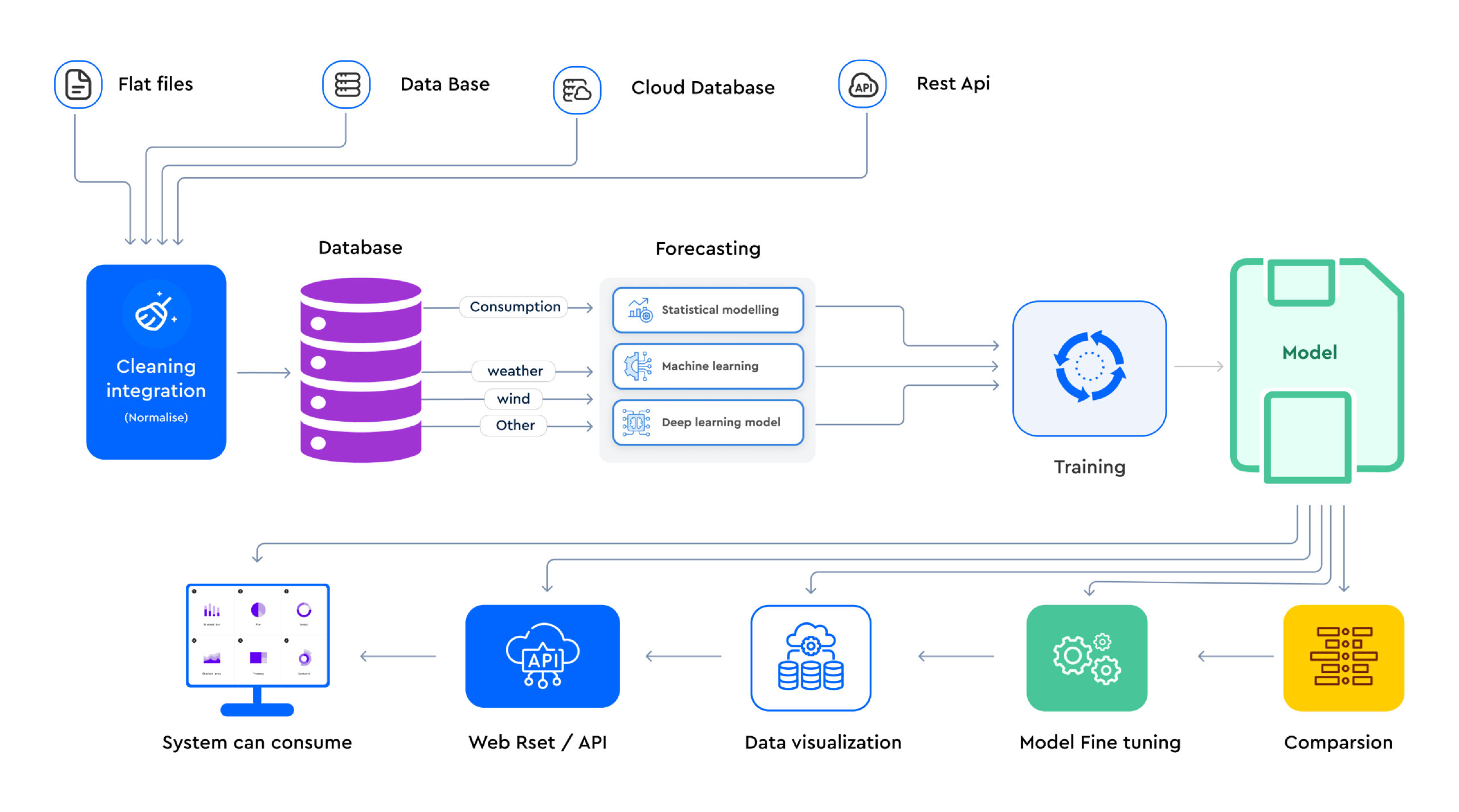TABLE OF CONTENT
Introduction
If you are looking for a ready-to-implement concept for accurate energy demand forecasting, you may have arrived at the right article. The discussion around energy demand forecasting has been around for a long time and several industry leaders have explored rudimentary models of prediction to implement across their systems and assets.
But the process has been lacking a crucial piece and has been unable to accurately predict consumption levels based on the umpteen influencing factors, and not just past data.
Scour the market and you would find very few solutions that are ready to implement, and comprehensive in functionality. This problem exists because of unsatisfactory models for data prediction - these models may look at past data but do not take into account external factors such as meteorological data or socio-economic factors.
The other problem is the intuitive representation of the data - existing systems fail to offer an easily palatable view of the data for engineers to make sense of and make data-driven decisions.
With all of this, the problem is ripe to be solved and requires the innovation of a wholesome solution that considers all the necessary data and offers a valid and clear representation of the data sets.
The need for accurate Energy Demand Forecasting
Energy demand forecasting is a process that helps energy organizations essentially predict customers’ future usage based on historical data of usage. For a complex system like energy production and distribution, there are several other factors besides only historical data, that may influence the consumption patterns which would be needed to be taken into account in order to arrive at more precise demand forecasting.
Accurate demand forecasting can help organizations organize their systems for optimal production & distribution and essentially help them optimize production schedules, inventory management & storage, distribution, and load balancing, to name a few.
This plays a crucial role in the energy sector, as it allows large energy companies and conglomerates, in tandem with local governments, to make real-time decisions in power systems planning and operations. This planning is usually done across 3 different time periods - short, medium, and long. And the more accurate the prediction systems in place, the better the planning can be across time periods.
In order to achieve improved accuracy, systems will not only have to take into account current and future weather conditions, for example, but also gauge how customers will react to them. Apart from weather conditions and how customers react to them, systems will also have to take into account factors such as prices, new technology, global market conditions, personal and public socio-economic conditions, etc.
Essentially, energy companies will have to model and organize operations, including production, according to the demand and influencing factors that govern consumption patterns. This would allow them to make the maximum profits and sustain minimal losses.
Demand for Energy Forecasting Solution
According to a report by Fortune Business Insights, the Global Energy Management Systems market which is a superset of the Utility and Energy Analytics market is forecasted to grow at a CAGR of 12% from 2022-29 and attain a market evaluation of over USD 60.54 billion in 2029.
The adoption and implementation of smart grids and smart meters have heralded a sea-change across industries and significantly contributes to the growth of the market. Digitalization that includes innovations in the area of data analytics & forecasting also contributes greatly to the global energy demand forecast mix.
Of the global markets, North America is the biggest adopter as these digital innovations rise in popularity. Major players including General Electric Company, Honeywell International Inc., Rockwell Automation Inc., and several other 3rd party software providers, based out of North America, are fuelling adoption rates with increasing innovation in the field.
The Utility and Energy Analytics market, which is based primarily on Demand Forecasting Solution providers is forecast to expand at a CAGR of 24.9% from 2022 to 2027, according to Mordor Intelligence.
According to the report by Mordor Intelligence, advanced analytics tools and techniques will be one of the vital components of adoption for Energy companies globally. At the helm of this transformation are innovations based on AI & ML methods and systems. Additionally, several vendors are innovating with ANN or Artificial Neural Networks, which is basically an advanced type of machine learning & AI.
The impact of renewable Energy
Ever since the onset of solar & wind energy innovations, there has been a parallel innovation trend in forecasting - from asset maintenance systems to production forecasting, there have been several new inventions that have made a robust model for solar fields and wind farms.
As more and more countries start to adopt such renewable energy models as mainstream options for energy generation, the need for optimally integrating these systems with existing grids came to be. This integration is not just about replacing fossil fuel energy generation models with renewable energy, but also about integrating Ml-based energy demand forecasting models into the new hybrid systems.
According to BIS Research, AI investments in the Energy Market are expected to reach USD 7.78 billion by as early as 2024, with a CAGR of 22.49% during the forecast period of 2019 to 2024.
North America is a leader in the energy sector and in the adoption of renewable energy models, and the US Energy Department announced in 2020, USD 30 million in funding for AI & ML research for renewable energy models.
Smart grids and smart meter systems, which are a part of the energy distribution ecosystem, have to be retrofitted with machine learning models that factor in the various factors that impact renewable energy prediction as well.
Several world leaders postulate that renewable energy production models would become completely mainstream, replacing fossil fuel permanently by 2050, and this has accelerated the need to adopt robust energy demand forecasting models across the board.
Forerunners in the field, IBM brought out their proprietary probabilistic solar power forecasting platform Watt-Sun as early as 2014 to offer a solution for intelligent ML-based demand forecasting. Several other tech innovators have come up with a range of solutions since, but the opportunities for investments and innovation keep growing exponentially, with newer systems being developed in the renewable energy sector.
Machine Learning Models for forecasting accuracy
Energy consumption prediction using machine learning has been around for a very long time and has been instrumental in the efficient planning and operations of energy production and distribution systems. Accurate load forecasting is essential for both short and long lead times and inaccuracies can lead to serious miscalculations of load balancing and ultimately cause an increase in operational costs and lost opportunities to sell excess energy to demand-ridden energy markets.
Electricity demand forecasting with Machine Learning can be categorized based on methods of accessing, such as time-series modeling, load profile analysis, pattern recognition, group handling models, artificial neural networks (ANN), and hybrid fuzzy neural approaches. The approaches and complexity of each method vary and implementation depends on the complexity of the data and the business case.
Additionally, in modern electricity distribution grid systems, forecasts of peak and total use alone will not be sufficient to accurately forecast the demands of the modern customer. A system that breaks down the data based on region, communities, and other demographics is necessary to accurately understand the complex and varied utility needs of current customers.
The deterministic components of the demand for a certain area, for long and medium terms, comprise residential & commercial demand, as well as a weather-dependant stochastic component. Forecasting models will have to ensure to leverage the predictable components of the data system first, before even considering the stochastic elements.
A more improved system would probably have to take into consideration special events and anomalies as well for increased energy demand forecasting accuracy. Newer technology concepts or models of ML such as Artificial Neural Networks and Group method data handling (GMDH) neural networks offer promising results and are worth looking into in detail. Several scholars studying modern electricity distribution grids and models have postulated the possibilities of deploying ANN & GMDH models for more accurate forecasting, almost human-like but only more intelligently and with more data.
-
Evolution of predictive models
Artificial Neural Networks (ANN) as the name suggests, are modeled after neurons, or the human brain model, and consist of various neurons or nodes that are connected with each other across several layers. These nodes (or neurons) are each programmed to detect and process different types of information independently of each other and pass on information to a central system that processes all the information, compiles the results, and presents a consolidated representation of said information.
ANNs are appropriate for implementation across various systems in pattern recognition and machine learning, and the applications of the model in energy demand predictions are also unprecedented.
GMDH or group method data handling neural networks are fairly new systems and are vastly unexplored. But this system also offers possibilities across systems and industries. In these networks, input variables, the number of layers, neurons in hidden layers, and optimal model structure are determined automatically. This means that the network is composed of a system of active neurons that operate almost autonomously. The GMDH network builds something called a polynomial model which actually offers a minimum error margin between the predicted value and expected output.
Conclusion
Energy demand forecasting technologies that leverage machine learning are not new but an energy forecasting solution that incorporates a range of machine learning models are much sought-after. The demand for such systems has already been established in the article and as a response to this void in the market, W2S Solutions started researching advanced machine learning models to present an optimal energy forecasting solution befitting the demands of the modern energy industry.
Case Study: Eneloop
Eneloop was conceptualized by the W2S AI & ML engineering team, as a robust forecasting solution that focuses on “time-series” models in the beta version, built with a unique workflow that allows creating forecasting models from near scratch.
Eneloop is also engineered to take into account statistical modeling and deep learning methodologies beyond machine learning to provide highly precise energy demand forecasting results, with a minimal margin of error.
Although originally designed to cater to the energy industry, the underlying architecture of the system is built to adapt to different data models from other utilities as well, such as water & waste.
Built to handle over 100 million data records concurrently, Eneloop offers the bandwidth required to handle dense and complex data sets across industries and business models. The advantages of the system are numerous, the core advantages of the system include rich flexibility and data handling capabilities.

W2S Solutions has a robust and mature ML engineering function and can help you engineer systems that are replete with the necessary functions to handle your business case. With extensive experience and a wealth of research-based expertise, the AI / ML team at W2S Solutions brings substantial skills and understanding to the table. If you are looking for a seasoned team that can help you leverage Machine learning models to create robust forecasting systems, look no further. Get in touch with our experts to understand how we can help you bring about ML-led transformation in your systems. But as you can understand, machine learning models run on data and you need to have a robust system of data that is clear & structured - engaging robust data engineering services from an expert data analytics and engineering services provider would be a great idea.
If you would like to know more about Eneloop and how it can help you achieve greater energy demand forecasting, our team has a ready-to-deploy POC that we will be happy to walk you through over a no-obligation call.
W2S Solutions is a global IT solutions provider based out of Texas, USA, transforming industries & businesses by leveraging cutting-edge technologies such as AI and ML.
Frequently Asked Questions
Energy forecasting or energy demand forecasting solves one of the most basic challenges of the industry - it allows energy organizations to forecast energy demand from consumers based on past usage data and other factors that may influence demand. These systems are built using advanced Machine Learning & AI models.
Accurate energy forecasting helps to ensure that the right amount of energy is produced and distributed at the right time, helping to reduce costs and improve efficiency. Machine learning techniques can be used to improve the accuracy of energy forecasting by analyzing data and making predictions based on patterns and trends.
Of the several machine learning models or methodologies used in forecasting, 4 are primarily being used by world industries right now. These include: straight-line method, using moving averages, simple linear regression, and multiple linear regression.
By analyzing historical data on energy demand, weather, energy prices, and other factors, machine learning algorithms can help energy companies to better plan for future energy demand and ensure that the right amount of energy is produced and distributed at the right time. With their ability to identify complex patterns and relationships in energy data, machine learning techniques are a valuable tool for energy companies looking to improve their energy forecasting processes and reduce costs.
The biggest challenges of the energy sector include:
1. Electricity transmission losses
2. Frequent power outages
3. Demand visibility
4. Grid modernization
5. Threat of cyber attacks


